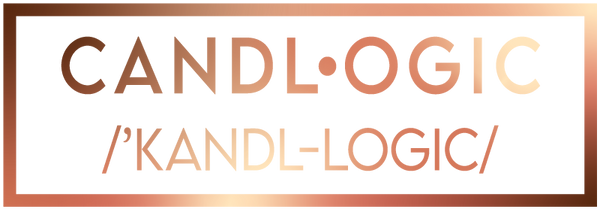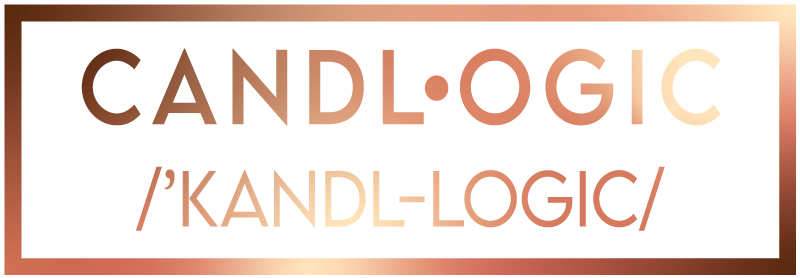FAQ
We believe transparency is part of true luxury...
Below are answers to some of the most common questions we receive about our products, ingredients, and burn performance.
Wax Transparency & Paraffin Policy
> “100% Soy” or “Paraffin-Free” Claims Aren’t Verifiable
Argument:
In the U.S., there’s no enforceable standard that requires suppliers to prove “100% soy” or “paraffin-free” claims for candle wax. Even if a supplier markets a wax that way, they don’t have to provide proof to brands or consumers.
Why this matters:
A label may reassure, but it doesn’t guarantee reality. If you’re sensitive to certain materials, accuracy matters more than slogans.
Understanding the Label - National Candle Association
Candlesciene – Candle Label Requirements
ASTM Industry Standards - National Candle Association
Candl•ogic’s stance:
We avoid absolute language we can’t verify batch by batch. Instead, we share what can be verified: supplier attestations, SDS documentation, IFRA category restrictions, and our own performance tests.
> Additives Don’t Have to Be Disclosed
Argument:
Wax suppliers are not legally required to disclose every additive or processing aid they use. Commonly added agents include hardeners, UV stabilizers, and other modifiers that aren’t visible on an ingredient list.
Elements of a Candle: Wax - National Candle Association
Why this matters:
A wax sold as “soy” may include undisclosed supporting materials, meaning a “100%” claim oversimplifies reality.
Candl•ogic’s stance:
We demand safety data and cross-check documentation (SDS, IFRA, Prop-65). What matters most is not whether an additive exists, but whether it’s safe, toxin-free, and compliant with our clean-ingredient standards.
> Additives Are Common—And Sometimes Beneficial
Argument:
Modern waxes nearly always contain additives like polymers, stearic acid, or microcrystalline wax to improve consistency, adhesion, scent throw, and burn quality. To claim “100% soy” is misleading at best.
Why this matters:
The performance customers expect—smooth tops, even burns, strong fragrance—often depends on carefully engineered, safe blends.
Candl•ogic’s stance:
We don’t demonize additives; we evaluate them. If an additive is food-grade, non-toxic, and compliant, we’ll accept it. Our focus is safe performance, not purity theater.
National Candle - Association Emissions Report (PDF)
> Trade Secrets Limit Full Disclosure
Argument:
Wax formulas are often protected as trade secrets, meaning suppliers don’t reveal full ingredient breakdowns—even to professional makers. Candle brands that insist they know every molecule are overstating their knowledge.
Why this matters:
Transparency has limits. Honest brands should acknowledge those limits, not pretend they don’t exist.
Candl•ogic’s stance:
We tell you what we know, what we can’t know due to trade-secret protections, and how we compensate (extensive supplier vetting, independent testing, clean-ingredient guardrails).
> The Honest Bottom Line
Argument:
Because of limited labeling laws and trade-secret protections, most candle brands cannot guarantee “100% anything” in any batch. That’s not their fault—but it is a fact.
Why this matters:
Consumers deserve clarity: what’s claimed, what’s confirmed, and how safety is ensured.
Candl•ogic’s stance:
We promise three things:
- No unprovable absolutes
- Strict ingredient guardrails (no phthalates, no parabens, no mutagens, and Prop-65 conscious) as we receive and keep watch on, manufacturers and suppliers (they are not required by law to send out updated SDS sheets to their buyers)
- Radical clarity about what’s verifiable, what isn’t, and why our choices protect your health.
> Do Candl•ogic candles contain paraffin?
Yes—up to >3% by volume, and it is fully refined, food-grade paraffin (CAS 8002-74-2). The other ~97% is a coconut-apricot blend. We disclose this because U.S. candle labels are not legally required to list wax ingredients, and many brands use unhelpful phrases like “natural wax” or “soy blend.” We prefer facts over buzzwords.
National Candle Association
CandleScience
> Why include any paraffin at all?
At very low levels, fully refined, food-grade paraffin improves burn consistency, glass adhesion, surface finish, and hot/cold throw—especially with wood wicks and seasonal temperature swings. This is not unrefined petroleum wax; it’s the high-purity grade permitted for use in or on food under FDA regulations (21 CFR §172.886 and related provisions).
eCFRCornell Law School
> Is fully refined paraffin “safe” to burn?
Independent testing and the National Candle Association report that well-made candles across all major waxes—paraffin, soy, beeswax, palm—produce virtually identical combustion byproducts and have not been shown to harm human health under normal use. Always burn with common-sense ventilation and follow proper Candle Care instructions.
National Candle Association (PDF)
> “Food-grade paraffin” sounds scary—what does it actually mean?
Ever had a chocolate bar on your way out of the store? You've eaten it. LOL!
“Food-grade/fully refined” refers to paraffin that meets strict purity specs the FDA allows in or on foods (e.g., coatings and certain applications) when used as directed. That’s the refinement level we use—high-purity, fully refined, not industrial grades. (We’re not saying “eat your candle”; we’re saying the paraffin grade we use is the same class of highly purified material permitted for food contact/uses.)
eCFRGovInfo (PDF)
> Why are “paraffin-free” and “natural wax” claims unreliable?
In the U.S., there’s no legal requirement for candle makers to disclose wax ingredients, and the main mandatory label is a fire-safety warning (ASTM F2058). That gap enables vague claims (“soy blend,” “natural”) that may still include undisclosed paraffin or additives. We disclose our composition instead.
National Candle Association
ASTM International | ASTMThe ANSI Blog
> Is there a “best” wax type?
According to the National Candle Association (NCA), no specific type of wax or wax blend is considered “best.” High-quality candles made from paraffin, soy, beeswax, palm, coconut, or blends all burn cleanly and safely when manufactured to proper standards. What matters most is formulation and testing, not the marketing label.
National Candle Associaiton – Candle Wax Basics
> Why don’t candle labels list all ingredients?
Industry labeling requirements (ASTM F2058, referenced by the NCA) are designed to protect consumers with fire-safety warnings such as:
- “Burn within sight”
- “Keep away from things that catch fire”
- “Keep away from children”
These are required on every candle. Ingredient lists, however, are not required by law, which is why claims like “100% soy” or “paraffin-free” cannot be independently verified.
National Candle Association - Read the Label
We know that was a lot to read, but so very important. We care about what goes into your candles, because we too burn our candles and use our products at home with our families, pets and children. We don't take any of this lightly, and neither should you.
How long do your candles burn?
Thanks to our coconut–apricot wax blend, Candl•ogic candles burn up to twice as long as traditional soy or paraffin candles.
- 13 oz candles: Approximately 70 hours of burn time (with proper care and wick maintenance).
- 6 oz candles: Approximately 40+ hours of burn time.
- 3 oz sampler tins: Approximately 14+ hours of burn time.
Burn times vary slightly based on burn environment and care, but with consistent trimming and proper burning cycles, our candles consistently outperform mainstream brands.
What kind of wicks do you use?
We primarily use wood wicks that provide a steady flame, less soot, and a soft crackle. Wood wicks are trimmed short (about 1/4”) for the cleanest burn.
We use cotton wicks only in one specific candle — they are not part of our standard line.
Are your fragrances safe?
Yes. Every fragrance is:
- Certified against IFRA’s global safety standards
- Screened with SDS sheets
- Prop 65 compliant
In addition, we go beyond compliance by rejecting any blends containing parabens, phthalates, carcinogens, mutagens, and soy, guided by updated toxicity reports as they are released. Because these updates are not always directly reported to us, we actively monitor and review them ourselves. If a material is later found to fall short of our standards, we immediately remove it from production — even if that means discarding finished products at a financial loss.
Why don’t you use soy wax?
While soy is often marketed as “clean,” it is one of the most heavily pesticide-treated crops in the world. It also has a tendency to burn unevenly and produce more soot. We believe coconut–apricot wax offers a safer, longer, and cleaner burn without compromise.
Do your candles produce soot?
All candles can produce some soot if burned improperly, but our wood wicks and coconut–apricot wax are designed to reduce it significantly. To keep your candle burning cleanly, trim the wick before each burn and avoid placing candles in drafty areas.
How should I care for my candle?
- Burn for at least 1 hour, but no more than 4 hours at a time.
- Trim wood wicks to 1/4” before each burn.
- Stop burning when 1/2 inch of wax remains.
- Store in a cool place with the lid to keep dust out.
Proper care extends the life of your candle and ensures the cleanest burn possible.
What makes Candl•ogic different from other candle brands?
Candl•ogic was created for people who thought they could no longer enjoy candles because of sensitivities and health concerns. We focus on safer ingredients, transparent sourcing, and integrity-first luxury.
Where other brands invest in packaging and inflated margins, we invest in your air quality, your well-being, and candles that burn longer, cleaner, and better.
Luxury. Redefined.
How much is shipping?
We keep it simple. Flat‑rate shipping starts at just $5.95 and goes up to $24.95 for very large orders. Most orders ship for $5.95–$12.95. Orders of $100 or more ship FREE within the contiguous U.S.
Do you offer free shipping?
Yes. Any order of $100 or more ships free anywhere in the contiguous U.S.
How do you decide which shipping rate I pay?
Rates are based on the total packed weight of your order, including packaging. This way, bundles and multiple items are always covered by one flat rate.
Which carriers do you use?
We primarily ship with USPS Ground Advantage and UPS Ground to provide the best rates and reliability.
How quickly will my order ship?
Most orders are processed within 5 business days. During the summer months, we ship Monday–Wednesday only, to protect your candles from weekend heat exposure in transit.
Do you deliver locally?
Yes. Free local delivery is available within 10 miles of downtown Elkhart, IN, and local pickup is available by arrangement.
What if my order is very large or heavy?
Orders above 10 lb fall into our bulk tier ($24.95). This ensures you always have a clear rate at checkout—even for big candle hauls.

